How hot does the ASUS TUF A15 get under different workloads with AMD’s Ryzen 5 4600H and Nvidia GTX 1650 Ti graphics? Let’s find out and see what improvements can be made to thermals and performance.
I’ve got the FA506II model here, which means we’ve got these specs, so expect different results with different hardware. I’ll be testing the 1660 Ti config in a future.
I’ll be testing the 1660 Ti config in a future.
Air comes in from the bottom, however there are no intake holes directly above the fans, instead air is forced through other holes which may be in an effort to bring air in over other components. 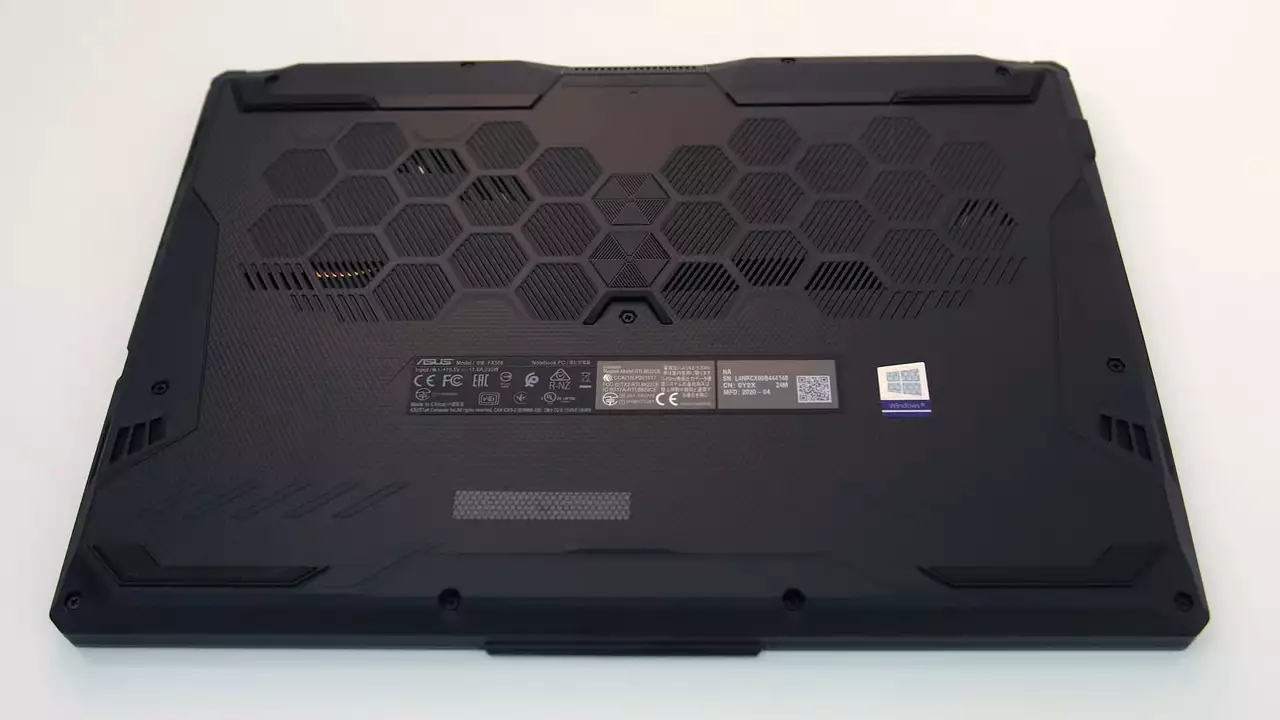 Air also comes in through the vents above the keyboard, and is exhausted out of back corners.
Air also comes in through the vents above the keyboard, and is exhausted out of back corners.  There are no exhausts on the left and right with this model, however the higher specced versions do have an exhaust on the right side.
There are no exhausts on the left and right with this model, however the higher specced versions do have an exhaust on the right side. 
 There are a couple of fans inside with a single heatpipe shared between the CPU and GPU, however this does actually differ based on the specs.
There are a couple of fans inside with a single heatpipe shared between the CPU and GPU, however this does actually differ based on the specs.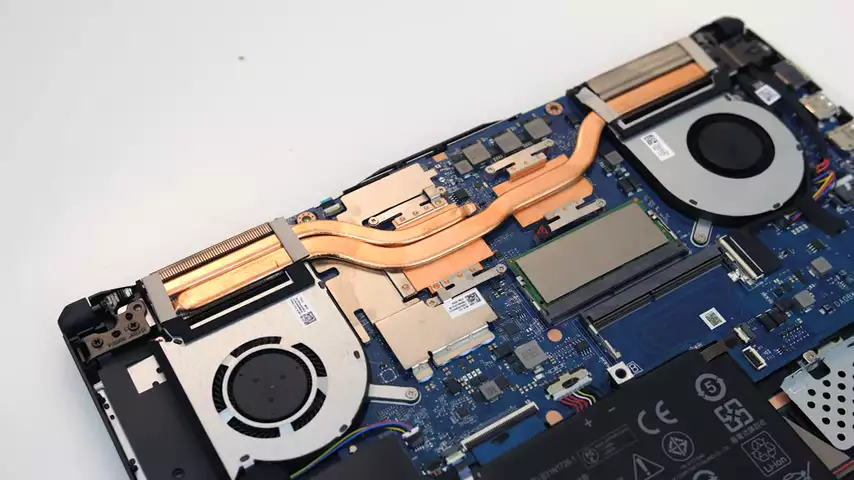
The A15 we’re looking at is shown on the right here, the left is the 4800H with 2060 model that I’ve already tested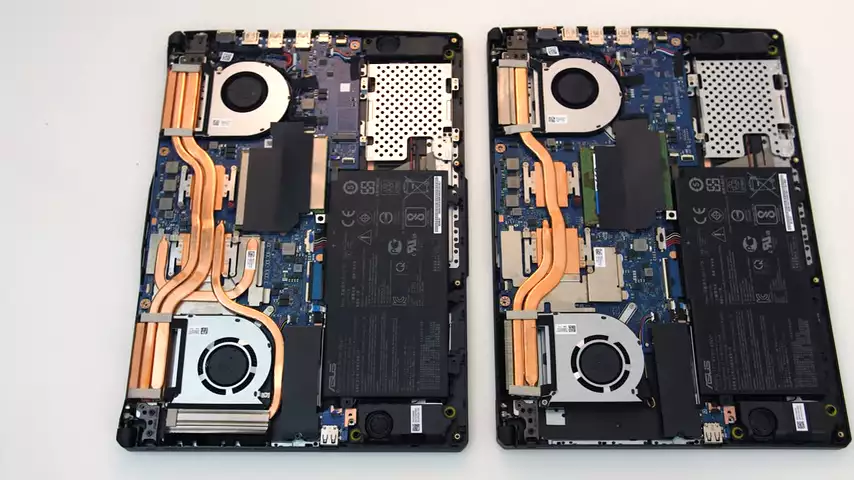 so this lower specced model has far less cooling capacity, presumably due to the lower tier specs.
so this lower specced model has far less cooling capacity, presumably due to the lower tier specs.
The ASUS Armoury Crate software lets you select between different performance modes which from lowest to highest are silent, performance and turbo. Turbo mode raises the fan speed, as you’ll hear soon, but only while under load, it doesn’t just keep it running maxed out. It also applies the following overclock to the GPU.
No undervolting to the processor has been done as there’s currently no support for this with Ryzen mobile, however we will look at disabling turbo boost.
Thermals were tested with a 21 degree Celsius ambient room temperature. Idle results down the bottom were fine.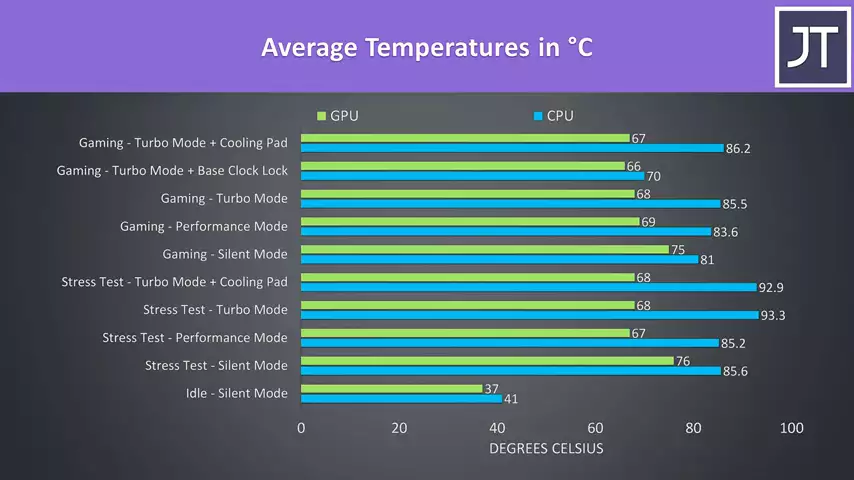 Worst case stress tests were done with the Aida64 CPU stress test with CPU only checked and the Heaven benchmark at max settings at the same time, and gaming was tested with Watch Dogs 2 as I find it to use a good combination of processor and graphics. While under these loads, silent mode was the warmest on the GPU, however the 1650 Ti was never thermal throttling. The CPU temperature doesn’t change much in performance mode, however the increase in fan speed does cool the graphics. Turbo mode raises the CPU power limit, so higher temperatures are reached. I’m not sure if this was thermal throttling or not, as software does not seem to report this for AMD systems like it does for Intel. I also tested gaming with the processor locked to its base clock, and this resulted in it running a fair bit cooler.
Worst case stress tests were done with the Aida64 CPU stress test with CPU only checked and the Heaven benchmark at max settings at the same time, and gaming was tested with Watch Dogs 2 as I find it to use a good combination of processor and graphics. While under these loads, silent mode was the warmest on the GPU, however the 1650 Ti was never thermal throttling. The CPU temperature doesn’t change much in performance mode, however the increase in fan speed does cool the graphics. Turbo mode raises the CPU power limit, so higher temperatures are reached. I’m not sure if this was thermal throttling or not, as software does not seem to report this for AMD systems like it does for Intel. I also tested gaming with the processor locked to its base clock, and this resulted in it running a fair bit cooler.
These are the average clock speeds while running the same tests. 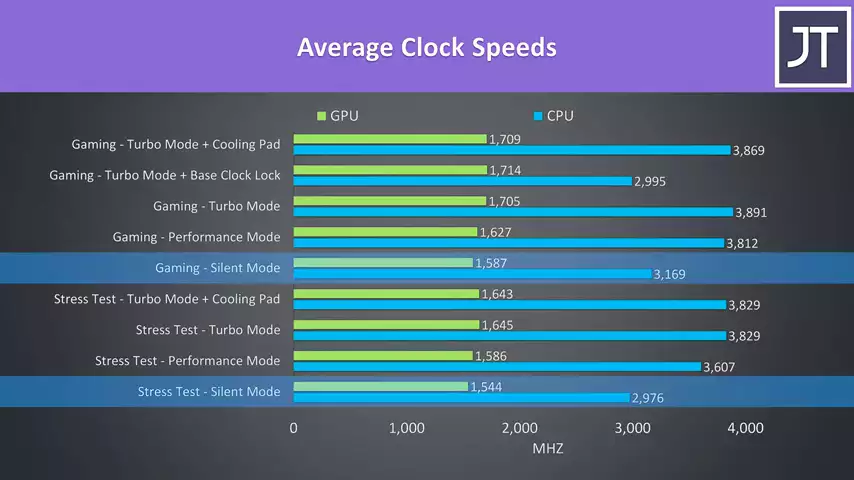 Silent mode isn’t too far off the 3GHz base clock, which is what the CPU runs at when we manually disable boosting. Performance mode gives us a nice improvement over silent, then turbo mode is able to hit 3.8 to 3.9GHz over all 6 cores under these heavy loads. We can see the GPU clock speed increasing in turbo mode as a result of the overclock applied by this mode.
Silent mode isn’t too far off the 3GHz base clock, which is what the CPU runs at when we manually disable boosting. Performance mode gives us a nice improvement over silent, then turbo mode is able to hit 3.8 to 3.9GHz over all 6 cores under these heavy loads. We can see the GPU clock speed increasing in turbo mode as a result of the overclock applied by this mode.
Looking at the power levels being reached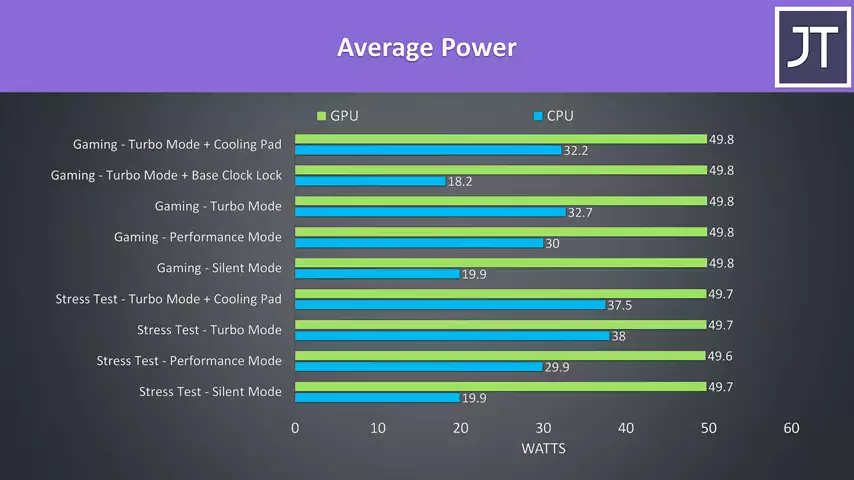 we can see that regardless of the mode selected, the 1650 Ti is able to run at its full 50 watt power limit. The processor on the other hand seems to get capped to 20 watts in silent mode and 30 watts in performance mode.
we can see that regardless of the mode selected, the 1650 Ti is able to run at its full 50 watt power limit. The processor on the other hand seems to get capped to 20 watts in silent mode and 30 watts in performance mode.
Let’s actually see how games perform with these different settings.
I’ve tested Shadow of the Tomb Raider with the highest setting preset using the game’s benchmark tool.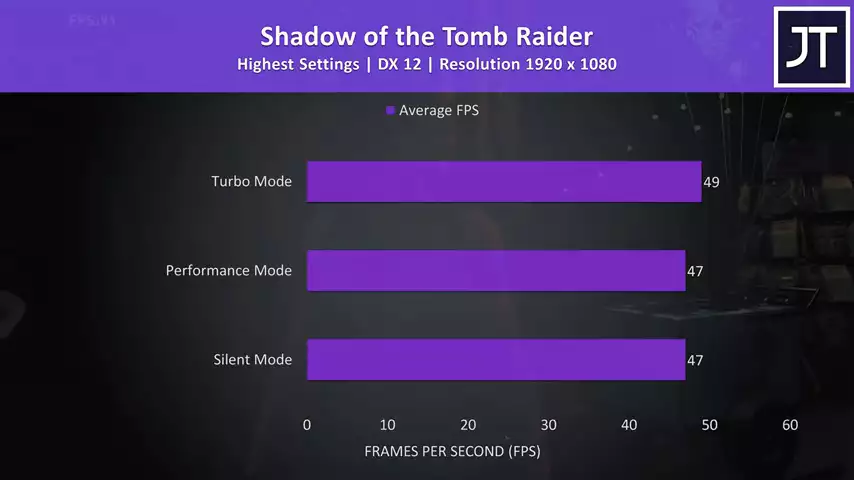
Sure enough there’s no difference between performance and silent modes in terms of frame rate, which makes sense, this is a GPU heavy test and the 1650 Ti isn’t being limited in any mode.
Here are the results with Watch Dogs 2, the game we actually looked at for the thermals earlier. 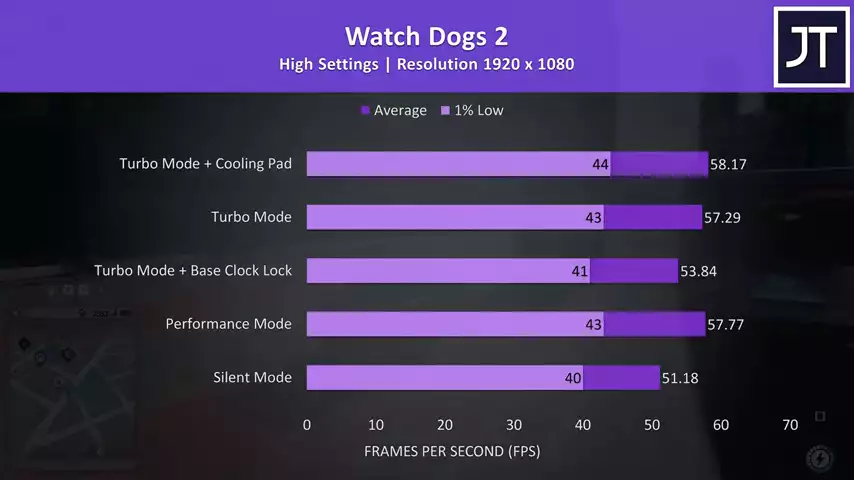 Performance mode was performing about the same as turbo mode, the cooling pad helped a little bit, and turbo mode with boosting disabled was a little better than silent mode. If you want to see more gaming benchmarks from this TUF A15, check the article where I’ve tested 20 games at all setting levels.
Performance mode was performing about the same as turbo mode, the cooling pad helped a little bit, and turbo mode with boosting disabled was a little better than silent mode. If you want to see more gaming benchmarks from this TUF A15, check the article where I’ve tested 20 games at all setting levels.
Now let’s take a look at a CPU only workload with the GPU idle.
Here are the clock speeds while running the Aida64 CPU stress test with all the default options checked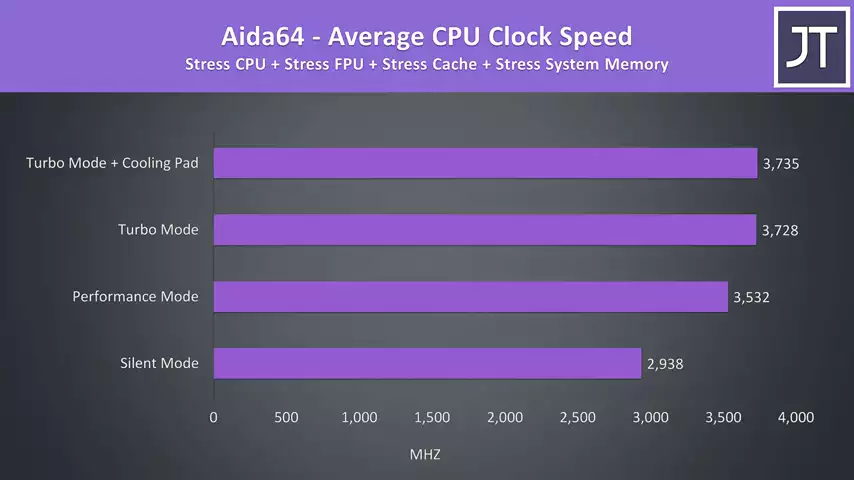 so we’re maxing out at around 3.7GHz over all 6 cores.
so we’re maxing out at around 3.7GHz over all 6 cores.
Temperatures were still hitting 90 degrees Celsius in this heavier CPU only workload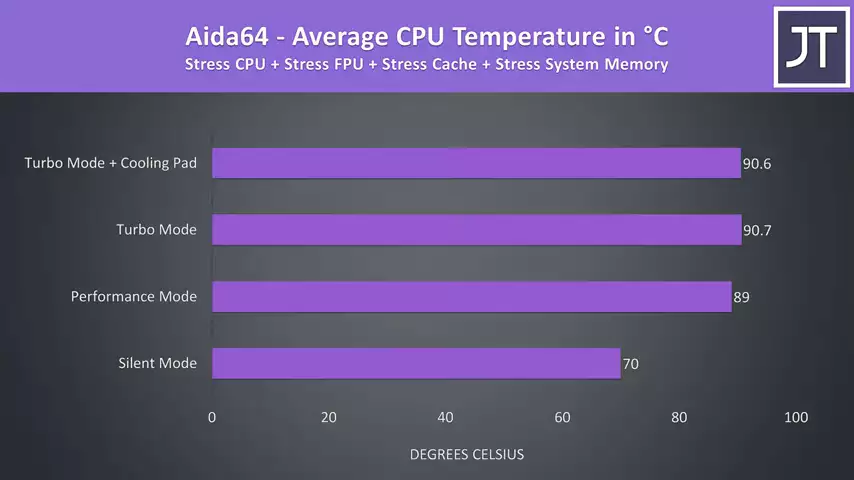 though silent mode was around 30 degrees cooler.
though silent mode was around 30 degrees cooler.
In CPU only workloads the power limit is higher than when the GPU is running at the same time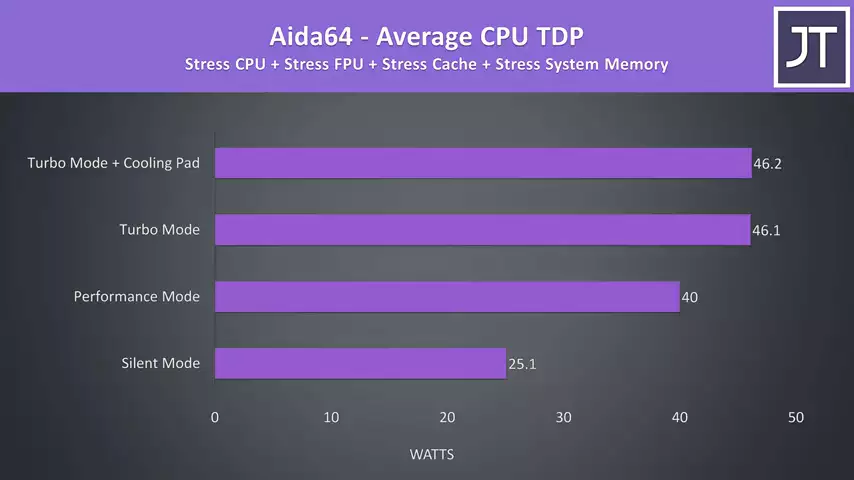 if you recall earlier in combined workloads the CPU hit 20 watts in silent mode and 30 watts in performance mode, so the CPU will perform better when the discrete graphics are inactive.
if you recall earlier in combined workloads the CPU hit 20 watts in silent mode and 30 watts in performance mode, so the CPU will perform better when the discrete graphics are inactive.
Here are some Cinebench results to give you an idea of CPU only performance when the GPU is idle. 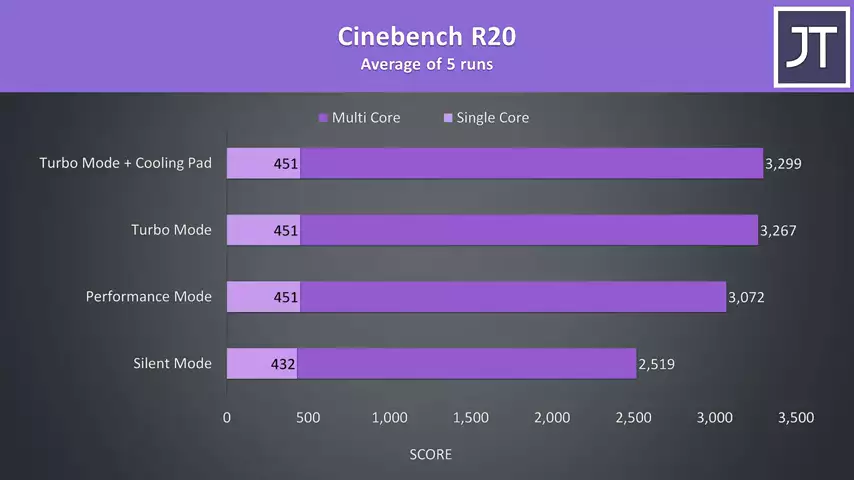 The single core performance was unchanged between performance and turbo modes, however turbo mode gave us a little boost in multicore performance.
The single core performance was unchanged between performance and turbo modes, however turbo mode gave us a little boost in multicore performance.
When we look at how it stacks up against others though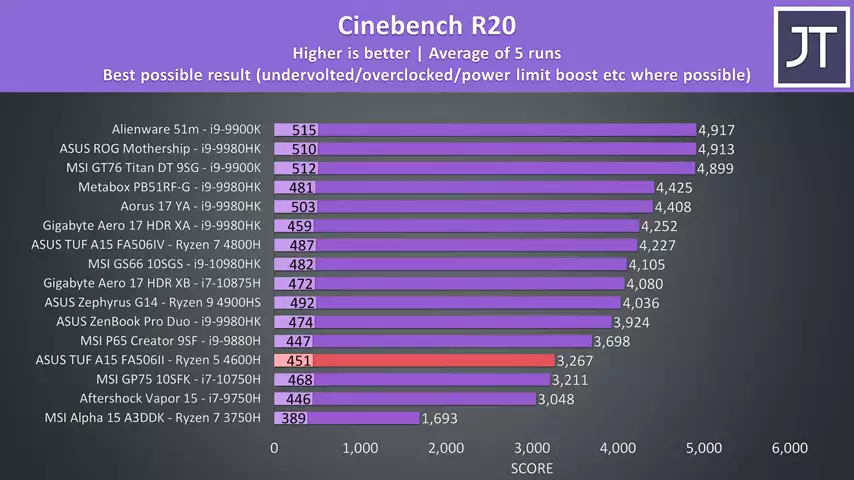 the 4600H is slightly ahead of an undervolted Intel i7-10750H with the same core count, a good result, though the i7 did have an edge in single core performance. Either way, these are still huge gains over AMD’s previous best option last gen, the 3750H at the bottom of the graph.
the 4600H is slightly ahead of an undervolted Intel i7-10750H with the same core count, a good result, though the i7 did have an edge in single core performance. Either way, these are still huge gains over AMD’s previous best option last gen, the 3750H at the bottom of the graph.
As for the external temperatures where you’ll actually be putting your hands, at idle it was hardly getting to 30 degrees, a good result.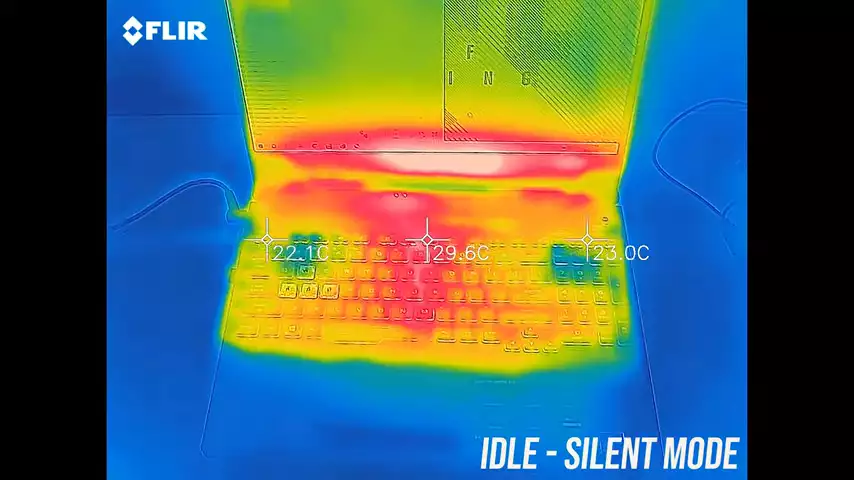 With the stress tests running in silent mode it’s warm in the middle, but the rest is still cool.
With the stress tests running in silent mode it’s warm in the middle, but the rest is still cool. 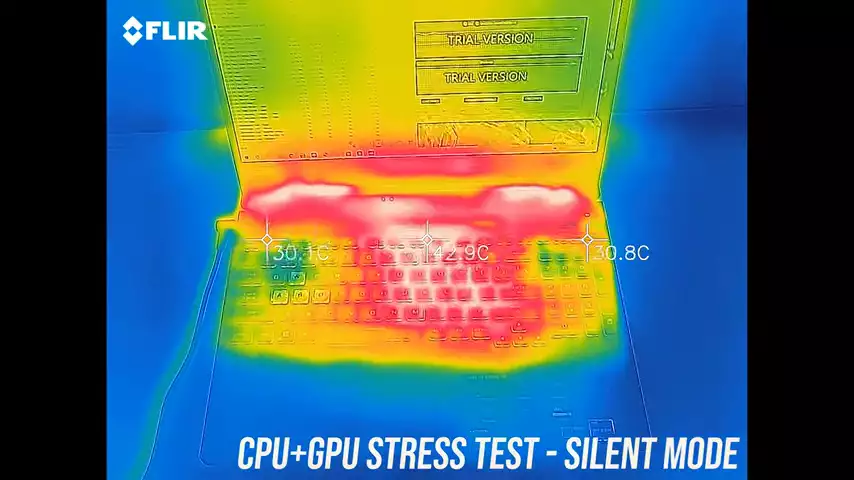 Stepping up to performance mode it’s a bit cooler despite performing better as fan speed increases
Stepping up to performance mode it’s a bit cooler despite performing better as fan speed increases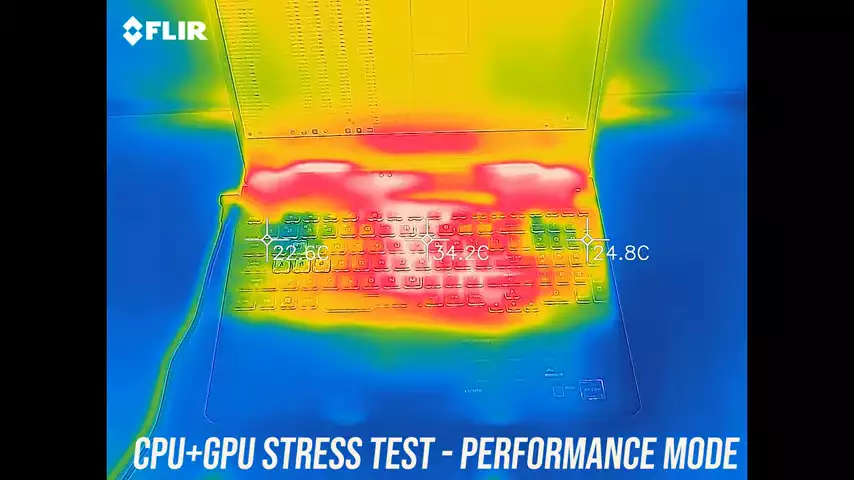 and it was similar in turbo mode which raises the fans further.
and it was similar in turbo mode which raises the fans further. 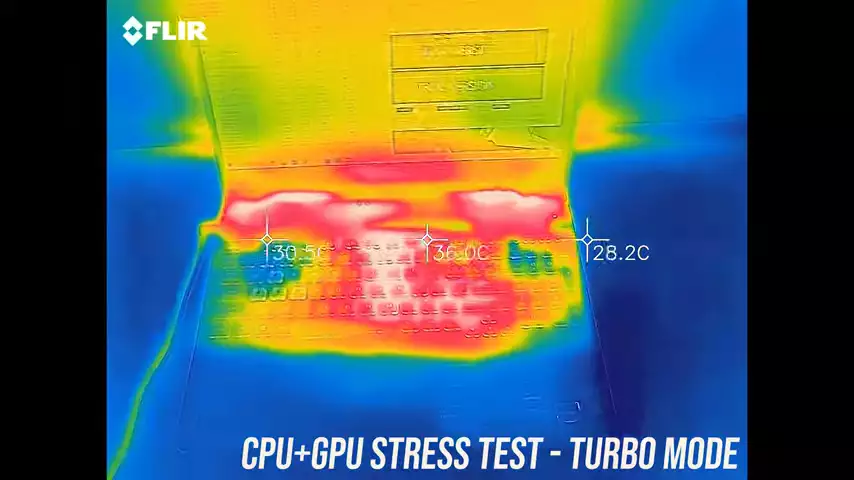 The fans were still audible at idle in silent mode. With the stress tests going in silent mode it’s louder, but still relatively quiet compared to most other gaming laptops, and as we saw earlier, you can actually play games pretty well in this mode.
The fans were still audible at idle in silent mode. With the stress tests going in silent mode it’s louder, but still relatively quiet compared to most other gaming laptops, and as we saw earlier, you can actually play games pretty well in this mode.
In performance mode it starts getting louder and is similar to most other gaming laptops out there, while turbo mode is starting to get quite loud, though I had no issues with headphones on.
Ok so the TUF A15 with these mid range specs does run on the hotter side, I was seeing up to 93 degrees Celsius at times under heavy load even with high fan speed. This is a bit sad, as it could likely have been mitigated if ASUS just used the same cooler that they’re using with the higher specced configurations, but I guess that would be an added cost, and they figured this one does the job. Most laptops run hot in these tests, so this could have been a good way to differentiate the laptop. It was possible to limit processor performance to the base clock speed if you want to prioritize cooler temperatures though, and as we saw in a couple of games, there wasn’t much of a difference in gaming performance as the GPU can still run at full power.
Despite the higher temperatures, the performance was still fair. In Cinabench for example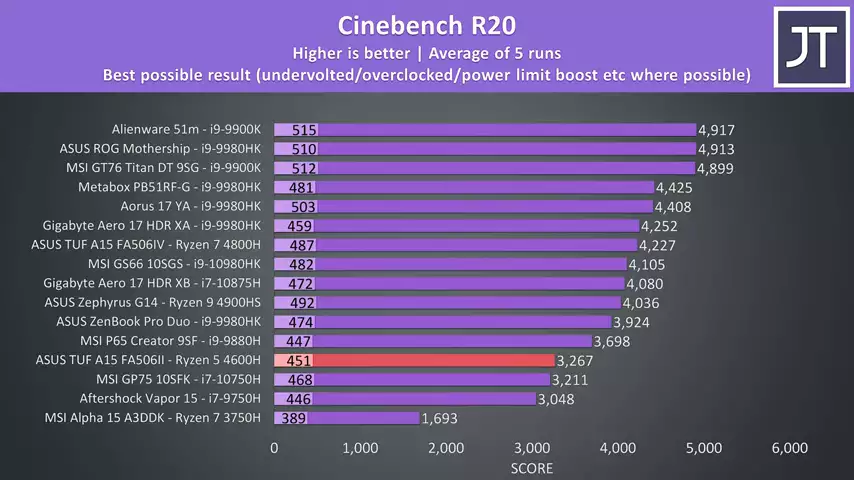 the 4600H was able to outperform an undervolted Intel i7-10750H, at least in multicore, it was a little behind in single core, still not bad and much better compared to last gen Ryzen 3000. Unfortunately there was no manual fan control as far as I could see.
the 4600H was able to outperform an undervolted Intel i7-10750H, at least in multicore, it was a little behind in single core, still not bad and much better compared to last gen Ryzen 3000. Unfortunately there was no manual fan control as far as I could see.
The plastic body was beneficial in that no matter what, the keyboard deck hardly felt warm even under worst case load. Using a cooling pad didn’t really help in any of these tests, so it doesn’t seem worth using with the TUF A15, and this seems to be due to the holes on the bottom that aren’t directly above the intake fans. I’m not recommending it, but if you’re willing, adding some extra holes may be beneficial.
These differences in performance shown aren’t hard and fast rules, there are different factors which will vary results, primarily the temperature of the room you’re running in, application of thermal paste, and even the specific hardware which comes down to the silicon lottery. It may be possible to improve thermals by changing the thermal paste, however I have not tested that here. I do wonder how much it would help though, given the limit seems to be more on air intake.
Let me know what you thought about the thermals from the ASUS TUF A15 gaming laptop down in the comments.


No comments yet